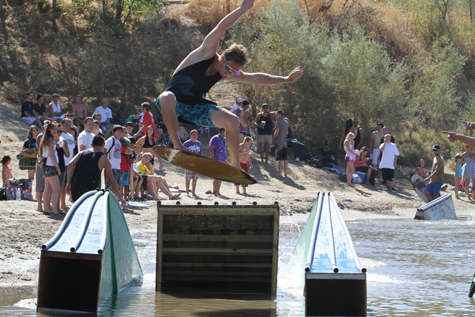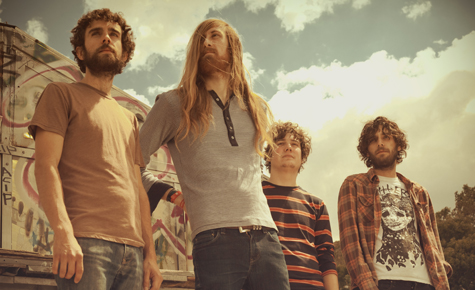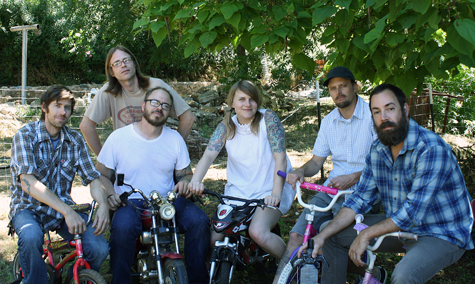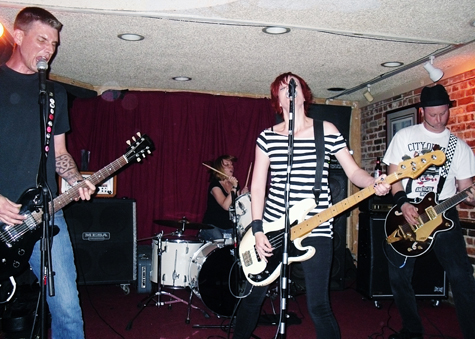Minus the Bear hits the road to play Highly Refined Pirates in its entirety
Touring is an easy way to lose track of time. Case in point: when Submerge asked the lead singer of Minus the Bear when he had arrived with his band in Raleigh, N.C., he simply replied, “I don’t know.”
“When we’re in a bus we just kind of end up places,” said guitarist/singer Jake Snider.
To celebrate their past 10 years of success, the Seattle-based band–Snider, guitarist Dave Knudson, bassist Cory Murchy, keyboardist Alex Rose and drummer Erin Tate–has embarked on a 10-year anniversary tour across the States that began in early October, playing their 2002 debut full-length album Highly Refined Pirates in its entirety at each stop.
Simultaneously, MTB has released autographed vinyl copies of the album, pressed for the first time since its release, in addition to releasing This Is What I Know About Being Gigantic, the band’s debut EP, on vinyl for the first time.
When Submerge spoke with Snider over the phone, the band was pitched in Raleigh, preparing to play a show at the Lincoln Theatre that night.
Getting Snider to open up about the tour, the band and the albums was like pulling teeth. This is possibly due to the fact that up to that point, the band had already been on the road for two weeks, playing a show in a different city almost every night.
“It’s easy not to think of what [the songs] mean when you sing them every night,” he said with a laugh. “It’s almost like being a machine sometimes.”
Snider was referring to the songs on Highly Refined Pirates, which he classifies as a pop record in comparison to the others. Despite its deceivingly ridiculous song titles, like “Get Me Naked 2: Electric Boogaloo” or “Damn Bugs Whacked Him, Johnny,” the album has a strong indie pop feel. It is replete with noodling guitars layered over fleeting drum beats and altering time signatures, broken up by musical interludes; nonetheless, the accompaniment of soft synthesizers and Snider’s tepid vocals keep the album invariably pop.
“[I was] definitely more just writing about what people at that age do, what it’s kind of all about,” Snider said in reference to the lyrics. “Not the going to work from 9-to-5 and whatever other bullshit you have to deal with. There’s some fun to be had, and I think that the escapism aspect of life at that age is what I was focusing on then, as far as I can remember.”
Compared to its successors, Highly Refined Pirates is sonically more simplistic, he said, meaning that playing the album live has been smooth sailing.
“For me it’s a lot less complicated. The rig that I use for the pedal board and the effects is really pared down back to more what I used to have in the early ‘00s,” he explained. “This tour has been fun, because it’s a lot more direct and a little bit less reliant on those digital crutches, I guess you could say.”
Since its formation in 2001, the band has released four full-length albums in addition to four EPs, the most recent being Hold Me Down, released early this May.
After Highly Refined Pirates, the band has continued to release a full-length album every two to three years. Menos El Oso (meaning “Minus the Bear” in Spanish) followed in 2005, largely inspired by the band’s time spent on tour in Spain. Then they released Planet of Ice in 2007, which fostered the band’s prog-rock reputation and led to a tour across Europe, Australia and Japan.
MTB churned out its most recent work in May of last year. Up to that point, the band had released its albums on the label Suicide Squeeze.
OMNI was instead released on Dangerbird Records and produced by multi-Grammy winner Joe Chiccarelli, who has recently worked with the likes of The Shins, My Morning Jacket and The White Stripes.
Whereas Planet of Ice reflected the allure of its mystical title, boasting warbling riffs and scuttling progressions, OMNI expanded beyond the band’s prog-rock trademark to meld pop, funk and trance in creating what is at times an exceedingly erogenous album. Many of the band’s songs have alluded to bare skin and sheets in the past, but none quite so directly as the songs on OMNI.
Like most experimental works, the album drew a mixture of reactions from critics–some praiseful, others blistering.
Pitchfork dismissed it as an overproduced pop record with oversexed lyrics delivered in a lackluster manner, while Paste Magazine called it the band’s most “explosive record since its 2002 debut.”
Snider shrugged off the negative reviews. “So they’re not fans. Who cares?” he said. “Music is just so subjective and so personal, I think, that unfortunately the record gets into the wrong reviewer’s hands when the reviewer next to him, [it] might have been up his alley.”
“Pitchfork makes a whole business on record reviews and trying to tell everybody what’s cool, and sometimes it’s just a few peoples’ opinions,” he added.
Critics aside, the band has sustained a solid following. Look no further than the tour’s sold-out shows in New York, Los Angeles, Portland and San Francisco.
Fans seem equally as jazzed about hearing Highly Refined Pirates as they are about hearing OMNI, based on audience reactions.
“Judging by the time we get around to playing the two songs off the newest record that we’re playing, which is just really late in the set, it seems like some of the people have been waiting for something that they knew,” Snider said. “Some of the old fans don’t know the new stuff and some of the new fans don’t know the old stuff, and they’re all in the same room together. So it’s a weird tour, but it’s fun.”
With each album MTB has kept fans guessing. The only constant is that the band has every intention to consistently progress their sound.
“I think we’ve just kind of moved on from where we were nine years ago and I don’t think there’s any danger of us going back there wholeheartedly,” Snider said.
The band is continuing its tour throughout the States alongside longtime friends and indie rockers The Velvet Teen, in addition to indie rock band Lonely Forest.
The tour ends in November with a scheduled finale at Showbox at the Market in Seattle.
Early next year the band will return to the studio to write and record their next album.
Surely, diehard MTB fans will be happy to know that when Submerge asked if the band would consider playing other albums in their entirety in the future, Snider replied “sure.”
Minus the Bear will stroll through Sacramento on Nov. 7 when they play Ace of Spades. The show will get underway at 7 p.m. and tickets are $20. You can purchase said tickets through Aceofspadessac.com.
Garrett Pierce taps the healing powers of lyrics on his new EP
Envision sitting on a boat along a murky jungle river in a downpour of a storm in Guatemala, watching the river boat captain try to navigate the boat, except for the fact that he is lost.
This wouldn’t seem like a time for laughter.
But for semi-local songwriter Garrett Pierce, the moment could not have been more perfect.
“I just started laughing. It’s one of those epiphany moments where things that were built up from my time in San Francisco were just kind of built up and went down that water,” he remembers.
These are the heavy emotions that often play out in Pierce’s songs.
This October, Pierce is releasing a four-song collection on the EP Everybody Breaks under Narnack Records, which will be followed by his full-length City of Sands, which is set for release in January or February 2012.
Everybody Breaks is both melancholic and uplifting. At times it feels like reading a diary in the gray of winter. “In Silence” is sung over the sound of a warped organ, while “Shape Us Like Waves” is a rich composition in which Pierce sings, “We are people of the coast, so we know that the waves can break if we make it so,” in a dreary ode to the Bay.
What has been a constant is Pierce’s passion for writing. His musical beginnings were fostered in Southern California, starting when his dad bought him his first acoustic guitar around age 12.
“The first thing I did was write, which was very strange. He wanted me to take lessons and learn blues guitar, but I had no interest in shredding, I guess. I just wanted to write,” he said. “It hasn’t really changed since then.”
Growing up in what is considered either the armpit or artistic mecca of California, depending upon your outlook, Pierce has immersed himself into music from a young age.
First he went through a grunge phase that morphed into a hard rock phase by the time he joined a rock band in high school.
Pierce remembers when he first dabbled with writing acoustic-based songs after moving back to Los Angeles.
“Everybody was trying to be Jewel or John Mayer or something on the acoustic guitar, and it was a terrible time for me because I had all these songs. I just didn’t feel like I had an audience yet,” he said.
It was during this time that a friend invited Pierce to move to Davis to start playing music.
He laughed at the question and asked, “Why on Earth would I move from L.A. to Davis?”
As it turned out, he said it ended up being the best move of his life. He established his roots as a songwriter and connected with the likes of Davis experimental indie band Sholi as well as Michael Leahy, a KDVS host and founder of Crossbill Records, which would eventually put out Pierce’s first two albums, Like a Moth and All Masks.
“L.A. was not the place for me, there was just all these people trying to cut you record contracts down there,” he said.
Davis provided something that L.A. didn’t. There was a tight-knit musical community and he could play his songs where people would listen to him as a songwriter. And it was at this time that other lyrically creative, acoustic-based performers like Joanna Newsom and Devendra Banhart began to garner attention in the music world.
“That was just a totally great time to be playing music,” he said.
Nowadays, Pierce finds himself again adjusting to new territory, this time in Sonoma.
When Submerge caught up with Pierce over the phone, he had just gone for a five-mile run through the oaks and pines.
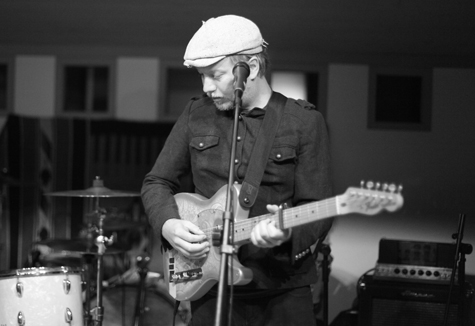
It sounds like you’re an advocate of having strong lyrical content.
Oh yeah, that’s the biggest thing for me. It doesn’t mean I don’t listen to music that doesn’t have lyrics. Thirty Three is one of my favorite bands, and they don’t have a singer. For me, it’s really important that people who are interested in my music think of it first as a lyrically based form, that writers are my biggest influences, taking from people like Steinbeck and Richard Wright, they are my biggest influences… Lyrics are huge, and shaping the right mood of the song around the lyrics is the most important thing.
Everybody Breaks struck a chord with me, both the EP as well as the song. You said some of these songs are older, but I was interested in knowing what you were feeling at the time you wrote “Everybody Breaks.”
That’s a tough one. I was talking to Nathan, our publicist, and just describing the songs to him, and I realized that the EP sounds pretty and it sounds uplifting even at times, but the lyrical content is on the darker side. I was thinking of long-term relationships and thinking about the body breaking down and all these dark feelings started coming together into one mass. I was listening to a lot of John Jacob Niles, an old soul folk singer, and my buddy who is Ellie Fortune, they both have this really nice, rootsy, folk guitar playing style. So I based the vibe of the song around this sparse guitar picking, and then the lyrics were just trying to lift me out of a funk of just thinking about the end of things.
And what about “A Bus in Africa?”
I was listening to NPR, and I heard this horrendous story, about–I think it took place in Uganda, if I’m correct–about this group of people in a bus who got pulled to the side by child soldiers, and pulled out of the bus and taken out at gunpoint, and people were put underneath the bus, and the bus driver was [forced] to get back in and run over the people, over and over. It was the most disturbing thing I had heard all year, and I couldn’t get it out my head, the image was terrifying to me.
For me, it’s harder to talk about those things sometimes. You don’t just want to bring it up in a conversation like that with your friends. So I take myself to a place where I can find out what was really happening in the minds of some of those people on the bus. It’s a first-person account, for some reason it’s the only way I could think to write it, and the chorus, like a lot of my songs, it’s not purely dark. The chorus has this amazing, positive chant, “That’s what love is for.” And it sounds very strange in juxtaposition to the lyrics that talk about these bandits that are killing everybody. But this person [has] this mantra of love for his family and why you need to have love so you don’t turn into these monsters that were taking the lives of people around them.
You were in an experimental noise band, 60 Watt Kid…
[Laughs] You have done some pretty good research. Where did you get that information from?
It’s amazing the things you find online. It looks like you were the drummer, and I listened to it, and I thought, “Man, what prompted this drastic change from you being in an experimental noise band to being a folk singer/songwriter?”
Well, actually those were concurrent. I was still playing plenty of solo stuff, but my whole goal when I moved to San Francisco was to be able to play my own music and kind of make a living from it… I just ran into them randomly at a bar in Oakland, and they said they were looking to hang out with new people and play music. He and this guy Derek had started this band 60 Watt Kid, and I invited them to play a couple shows with me. They were looking for a drummer, and I said, “Hey, I think I know how to play drums. And I’ll play with you guys until you find somebody.” And we just ended up clicking really well. The songs actually started more acoustic-based. We were like a lot of people at the time, we were listening to a lot of Animal Collective and it definitely showed in some of the earlier recordings. And then it just kind of got crazy… We would play characters on stage too, and dress up in sparkly weirdness. And I would kind of go caveman crazy on the drums. I was playing all four toms and a cymbal, and a tambourine around my ankle. It was not very complicated drumming, it was that caveman tribal stuff. It was so good to be physical, and we would break stuff and yell at each other’s faces. It was more Andy Kaufman, honestly. It was wild and it was so much better than standing with an acoustic guitar for me, for a little bit. It was a performance aspect I had missed since I was in rock bands in high school.
Garrett Pierce’s Everybody Breaks is out now on Narnack Records. He’ll celebrate the release in Sacramento on Oct. 21, 2011 at Bows & Arrows. Look for his new full-length album early next year.
Capital Stage starts its 2011—2012 season in a larger space
A theater company six years in the making will start this year’s play season on Oct. 7 at a new location–the Old Armoury on J Street in the heart of Midtown.
Capital Stage, which for the last six years has been tucked away inside the Delta King in Old Sacramento, has been relocated to a space that not only provides the theater company more space but also allows it to establish its identity.
“Even though we had been working [on the Delta King] for years and winning awards for our work, the bulk of the community still had no idea who we were,” said the company’s founding director Stephanie Gularte. “Now we’ve got this amazing storefront presence.”
This year’s season will start on Oct. 7, 2011 with the comedy Superior Donuts, the story of an owner of a poorly kept donut shop in uptown Chicago whose work ethic is challenged by the spunk of a new employee. It will feature a nine-person cast, which Gularte considers large for the company.
This is a busy time for Capital Stage, with the start of the season just around the corner. Nonetheless Submerge managed to finagle a chat with Gularte over the phone in the midst of her busy schedule.
The company has placed great emphasis on producing bold, innovative and intimate plays since its inception in 2005. In fact it’s engrained in their mission statement. They must be doing something right: last year the company received five stars for its entire season of plays from the Sacramento News and Review.
“We believe live theater is such a communal experience and opportunity for our audience and artists to have an experience together that is really kind of elevating, that goes beyond just entertainment,” Gularte said. “We like to explore strong ideas and try and create an experience for the audience that is memorable and provocative.”
This experience is partially created by providing the audience an opportunity for introspection as members of society, in a sense holding up an invisible mirror to reveal human reality.
“We have so many opportunities to be alone and be behind our computers at a safe distance,” she said, “But live theater particularly gives us the opportunity to do work that is thought-provoking and challenging, [and] provides an opportunity for a more visceral and community experience around that introspection.”
The desire to provide this unique experience is what brought Gularte and partners Jonathan Williams and Peter Mohrmann together to begin Capital Stage back in 2005.
Up to that point, although she was living in Sacramento working as an actress, Gularte found that the plays she found most provocative and interesting were those she was working on in the Bay Area.
Rather than relocating to the Bay Area, Gularte made it her mission to bring provocative theater to Sacramento. Thus, with the cooperation of likeminded individuals Williams and Mohrmann, Capital Stage was born.
This season’s string of plays should not disappoint. The plays are expected to be just as thought-provoking and introspective, Gularte said, if not more so.
They also all have a very American vibe, she said, and are what she considers to be American theater at its best. Several of which include the work of groundbreaking playwrights of the last couple of decades.
“This is an important time in our culture to see who we really are as a nation and where we come from and where we’re going,” she said.
After Superior Donuts, the season will continue with a diverse set of plays that include subject matter ranging from the Iraq War to a scientist’s wife in the 1800s.
With higher ceilings and a larger stage area, the new location is allowing the company to add more creativity to their sets and cast more actors. The seating capacity is also increased by 15 percent from the old location.
The hope is that with the new space, Capital Stage will also attract new audience members.
”We have a really smart, dynamic, passionate audience base and I just want more of those folks,” Gularte said. “I look for opportunities to surprise our audiences and take our subscribers in particular, who commit to the entire season with us, on a real journey.”
For those who are all too eager to see what the upcoming season brings, Capital Stage will be performing sneak previews of Superior Donuts as well as a new, one-woman show that the company will debut at Midtown Modern Arts Festival on Oct. 15. And for those needing an excuse to celebrate, the company will hold its opening gala on Oct. 21.
Capital Stage’s Superior Donuts will be in previews from Oct. 7—14 , 2011 and officially open Saturday, Oct. 15 with a run that will last through Nov. 13. More information and tickets can be found at Capstage.org. Don’t forget to catch Capital Stage members in action at Midtown Modern Arts Festival on Oct. 15. Event is free, starts at 12 p.m. and is taking place on 20th Street in between J and K streets.
Sacramento Skimfest Puts The River City on the International Skimboarding Map
One day every summer, people line the American River to watch guys, and the occasional girl, go airborne on skimboards at Paradise Beach. Riders, as they’re called, propel themselves along the water before launching off ramps and grinding rails.
This is Sacramento Skimfest, a flatland skimboard competition that attracts sponsored riders from as far away as Ontario, Canada, to compete. Running on its 15th year, it is known for attracting some of the best skimboarders in the world, as well as being one of the longest running flatland skimboard competitions to date.
“Skimfest has I think the best reputation of any flatland comp in the world so it’s quite a big deal,” Sam Price, owner of New Zealand board company OXS Skimboards, said via e-mail.
Greg Krolczyk, director of the skimboard retailer Skim City, is a wave rider himself, but he expressed mad respect for Sacramento’s flatland riders over the phone.
“I’ve seen the videos. They’re killing themselves. They’re skimming on nothing,” he said. “God bless them. I appreciate their imagination and dedication.”
Think of flatland skimming as skateboarding just beyond the water’s shore, minus the wheels.
Riding a wooden board over hand-built ramps made of wood and PVC, in water that is only inches deep, is risky business as far as Krolczyk is concerned.

Lon Porteous
Little did Skimfest cofounders Lon Porteous and Mark Robinson realize that when they began blending the features of skateboarding with flatland skimboarding in the ‘90s, they were pushing the sport into new territory that would have wide-reaching influence.
It is the innovation and longevity of Skimfest that has put Sacramento on the map in the skim world.
Unlike wave riders, who flock to Laguna, Malibu and Florida to skimboard, flatland riders can ride on any large body of water.
“Ninety percent of the people in the world don’t live near a break you can skimboard at,” Porteous said, but most people live near a lake or river where you can set up skim ramps.
And Paradise Beach along the American River has been a hotspot for flatland skimming for years.
This is where the new school of flatland skimboarding started, Porteous said. He has been skimboarding for the past 25 years, starting in his teens. At that time, performing an ollie on a skimboard was unheard of.
These days, Sacramento Skimfest draws an average of 60 competitors, including about 30 sponsored riders, to Paradise Beach each year. Competitors travel from nearby locations like Granite Bay and Yuba City, and further locations like Utah, Washington and Vancouver, British Columbia. Competitors are broken up into the beginner, intermediate or pro division, which consists entirely of sponsored riders.
Pro flatland riders like Blake Zimmerman and Lexi Hutchings have shown up to compete in past years, in addition to pro ocean riders like Brandon Rothe and Morgan Just.
Matt Matteucci, a local flatland rider whose past sponsors have included Kayotics Skimboards and Ground Zero Boardshop, is currently the primary organizer of Skimfest. After competing in 2005 he became increasingly involved with Skimfest in the following years.

Matt Matteucci. Skimfest, 2010.
Along with Porteous, he did most of the legwork to produce Nothing Is Cool, a film of the flatland skimboarding scene in Sacramento that came out under Blister Productions in 2007.
Though Robinson is no longer involved, Porteous has recruited other local riders like Matteucci to help keep the competition going. At this point, Skimfest is the only flatland skimboarding competition run by riders, Porteous said.
Each year, a couple of weeks before Skimfest, Matteucci, Porteous and other riders build the ramps, which are often inspired from setups used for skateboarding or snowboarding.
The event has been on the up and up as the skimboarding scene has continued to grow over the past five years, Porteous and Matteucci agree. The event’s increase in popularity, along with its generous first place prize, has doubled the number of sponsored riders since its early years. Last year, the first place winner of the competition received $1000.
Submerge had an opportunity to speak with Porteous and Matteucci about the evolution of Sacramento’s skim scene, the shortage of female competitors and the far-reaching influence of Skimfest. The following is an excerpt from the conversation.
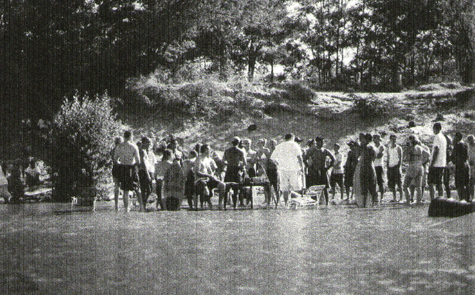
2nd Annual Sacramento Skimfest, 1998.
So tell me a little bit about the scene, the skimboarding scene here.
Lon Porteous: In the ‘20s, they started flatland skimboarding down South, the lifeguards did, so they could travel faster up and down the beach. So from there, flatland skimboarding started. It progressed in the ‘70s. It went more toward ocean skimboarding, which is more, “OK, let’s ride out into some waves.”
So, where I come in, is growing up in Sacramento, part of the skateboard side of it [was] we realized we could do a lot of our skateboard tricks on our skimboards. So, we ended up taking a lot of stuff and crossing it over, at a time where people were just basically sliding down the beach or trying to do headstands or basic tricks.
We turned around and were like, wait, we could ollie a board, we could make rails. You know, we could do a rail slide, we could do everything we do on a skateboard. So me and a guy named Mark Robinson… we ended up progressing it.
In terms of who’s putting together all the ramps and stuff…
Matt Matteucci: You’re looking at us right here. I mean we have other people that build. Most of the time we build at [Porteous’] house.
So I get the impression that this is more of a guy’s sport. Is that accurate?
LP: Yes. And no. We had more girls in our first year at Skimfest than we have now, which was great. There are some really, really talented girls that skimboard. Unfortunately, the girls that came through in Sacramento are no longer living in Sacramento. They have also progressed. There was a girl on my skimboard team, and she is now an ocean skimboarder. She competes.
And so, I think it just depends, because without a major influence like that, you know, somebody that a lot of girls can look up to and say, “Yeah, I could be as good as her,” or “I can do that” … they don’t have anybody to really be that role model. But there are scenes that have a really good girl turnout, like Washington, Vancouver. I would even say Utah had a pretty decent girl turnout.
I would be happy if I could just have four girls come that want to compete. I would bend over backwards to do whatever they want. But you go down to the river and it is all guys.

Lexi Hutchings. Skimfest, 2010. Photo by Kevin Fiscus - www.kevinfiscus.com
Yeah. I was hanging out over there one day, and some guy tried to show my friend how to skimboard. She got a nice red raspberry on her ass. I mean, it was her first time.
LP: Yeah, and I have the same raspberries, so tell her not to feel bad about it.
Speaking of [that], I was looking at some of those videos, there are some really crazy ways that people go down on those boards. Do you get people who are really injured, or …
LP: We never, ever, ever have had people get really messed up or anything. I mean, yeah, the normal rashes, scrapes. Most of the time, the worst thing that happens are elements in the water. So glass or something like that. Or nails. Like I’ve seen one kid have a nail go completely through the bottom of his foot. Yeah, and there’s nothing better than a rusty nail that’s been lying in the water. You probably end up with the same injuries you’d get skateboarding, like you break your hand or you break your wrist.
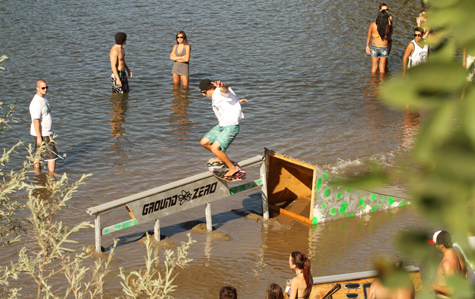
Brent Lippincott. Skimfest, 2010. Photo by Kevin Fiscus - www.kevinfiscus.com
Would it be accurate or fair to say that more people know about Skimfest outside of Sacramento than the people in Sacramento? And how far out do we have a reputation?
LP: Global. Worldwide.
Put it this way, you don’t know how big of an influence you have on other places until you go.
When [Price] got here, I had chests of old swag, Skimfest shirts, stuff like that, that are new. And he said, “You don’t even understand how much this stuff would be worth [in New Zealand].” And I was like, “What do you mean?” [He said] “People covet you guys, you don’t even know, because you’re from Sac.”
And so here are these people saying how much influence we’ve had on their scenes. And it was nuts, because I just thought I was giving him some Skimfest shirt.
Sacramento Skimfest 2011 will celebrate its 15th year on Sept. 10 at Paradise Beach (Glenn Hall Park). Registration runs from 9—11 a.m. and the competition will take place from 12—4 p.m. Registration fees vary depending upon your level.
Tiana Vega proves giving never goes out of style
Since its opening in February 1921, a wealth of artists has performed within the grandiose bowels of Sacramento’s Memorial Auditorium, including the Rolling Stones, Beach Boys, Duran Duran and Melissa Etheridge. It was the auditorium’s grandeur and antiquity that convinced the semi-local women’s clothing designer Tiana Vega that the annual Designing Dreams fashion show should also take place there.
“For some reason, walking in there feels like you’re walking into New York,” Vega told Submerge over the phone from her hometown in Jackson, Calif. “I’ve never been to New York, but that’s what it would look like if you were walking into an old, established building in New York.”
Not to mention that last year’s premiere event was the first fashion show at the auditorium since the showcase of Coco Chanel’s collection in the ‘50s, according to Vega.
This marks the second year of Designing Dreams, an event dreamt up collaboratively by Vega and Jennifer Richards, CEO of the Sweet Dreams Foundation. The show will feature the work of 11 designers from both Sacramento and San Francisco, including Vega’s, complete with 120 models walking the 90-foot runway.

Designing Dreams, 2010: Melissa Kay Collection / Photo by Igor Kondrya
Beyond a fashion show, Designing Dreams is a charity event. The proceeds from the evening will go toward one of the foundation’s bedroom-designing projects. The foundation’s mission is to design “dream” bedrooms for children who suffer from life-threatening diseases in order to aid their healing processes. Thirteen-year-old Cassidy, a Folsom resident who was diagnosed with a malignant brain tumor in January last year, will be granted her dream bedroom using this year’s proceeds.
Last year the event raised enough money to successfully create a dream bedroom for 8-year-old Aimee, who suffers from severe sensitivity to ultra-violet radiation. The project’s goal was to essentially bring the outdoors to her playroom.
In the past Vega has been hesitant to organize fashion shows, especially because so many designers hold them regularly here in Sacramento. Building awareness for a line is understandable, she said, but in Los Angeles designers are focused more on selling their clothing in boutiques.
“So that’s why when I decided to do Designing Dreams I wanted to make sure it was a first-class event and have the buyers there and basically do it right,” Vega said.
This includes making sure the event gains widespread attention.
“You spend a lot of money and a lot of time doing all these outfits, and what’s the point of doing them if you’re not getting the right people to look at your stuff?” Vega said.
Still, she has participated in many events, and her work has been showcased the past two years in Sacramento’s Fashion Week. But Vega makes it a point to participate in charity events, like the Giveback Gala Fashion Show she was a part of this past April.
“I’d rather do shows where basically I’m all for the cause,” Vega said.
While in pursuit of a charity to collaborate with for a trunk show several years ago, Vega discovered Richards at one of the Sweet Dreams events and felt an immediate connection to her cause.
“Working with someone who loves absolutely what they’re doing and every minute of it and not making any money off of it, that’s very inspiring,” Vega said.
The two young designers decided to collaborate and quickly realized that their vision was bigger than a trunk show, so they decided to put on a fashion show instead.
As Vega sees it, she and Richards share a passion for designing the dreams of others, one through fashion and the other through interior design; hence the name Designing Dreams.
Vega’s own fascination with design began at an early age, starting with her childhood days tinkering with dolls and sewing their clothes. Her intrigue with fashion grew throughout her days at Argonaut High School in Jackson, peaking when she was a sophomore interning at a law firm.

Tiana Vega Collection 2011- Margaret Mary / Photos by Vang Studio Photography
“I was finding myself sketching more than anything and having more fun dressing up to go to work than actually being there and taking care of the stuff I had to do,” Vega said.
After high school she relocated to Los Angeles to attend the Fashion Institute of Design and Merchandising, where she learned draping techniques, how to make patterns and how to sew.
Shortly before graduating with her degree in fashion design in 2008 she met Dave Icarangal, who would eventually become the cofounder of her contemporary clothing design venture. The two reconnected when she moved back to Northern California.
For the past two years she has been living back home in Jackson, selling her custom pieces online. However, the designer plans to return to Los Angeles in the near future, where she anticipates a better market to sell her collections.
Though she expresses admiration for the extravagant, over-the-top creations of designers Betsey Johnson and Monique Lhuillier, Vega does not look to others for inspiration. Rather, her inspiration stems from timeless, elegant looks of eras long past, especially those of the ‘30s and ‘40s.

Tiana Vega Collection 2011- Margaret Mary / Photos by Vang Studio Photography
“Honestly, I try to break out of my shell and do something crazy, like Lady Gaga-ish, but I can’t do it,” Vega said. “I always end up going back to something classic and tailored.”
Vega’s work is feminine and chic, intricate collections that usually take the artist two to three months to produce. Her fall/winter 2012 collection, the Margaret Mary collection she fashioned in remembrance of her grandmother, includes fitted, tight-fitting dresses with flattering necklines, or boxy cropped jackets consisting primarily of solid colors. Her collections have included bridal pieces, formal gowns and custom wear.
“I’m old school, so I always go back, like ‘30s, ‘40s, I love those looks,” Vega said. “It’s so sophisticated and sexy and I love it.”
A scene in a video for which she was a stylist inspired the 2012 spring/summer collection that will be featured in this year’s show. The scene was of a croquet match, so the clothing has a sort of Hamptons feel with a preppy vibe, she said.
Designing Dreams will feature six other Sacramento designers, including Maisha Bahati, Janelle Cardenas and Samuel Parkinson, in addition to returning designers Melissa Kay, Yennie Zhou and Nelli Rosh. Four San Francisco designers will also feature their work: pair Aya Yoruha and Diane O, Shirali Singh, Vasily Vein and Violetta Vieux.
The collections featured will cross a spectrum of looks for both men and women, ranging from ‘50s-inspired, classic pieces by Cardenas, to the surprising and chic looks of Aya Yoruha, Vega said.
Even over the phone, the designer’s excitement was apparent.
“We have a great lineup,” Vega said. “I am so excited, I am trying to slow down.”
And, as if the show of massive proportions wasn’t enough, organizers have confirmed that the runway show will open and close with performances by the Sacramento Opera. A grand night for a great cause.
Ganglians release a new double LP, Still Living
Forget rolling joints or slamming pills. Pop on a pair of headphones, shut your eyes and listen a while, and within minutes you are high as a kite. Meth huff? Easy. Coke snoot? No problem, just queue the track on your laptop. Wouldn’t it be nice if a high was as easy as paying 99 cents for an audio delivery of pure ecstasy?
In fact, the audio drug fad has recently caught media attention as parents debate whether or not “i-dosing” is in fact getting their children high. Communities in the Midwest have been particularly stressed about it, Ryan Grubbs, frontman of Sacramento’s psychedelic acid pop act Ganglians mentioned in a recent conversation with Submerge.
There was a sense of amusement in the way he described how genuinely terrified parents are by the thought their children might get hooked on ear-fed drugs. While the notion is laughable, the Montana native weighed in heavily on the effect music can have on the body, especially when it is delivered through headphones.
“We’re all guilty of listening to music on laptops and stuff,” he said.
But there is no musical experience that quite compares to an array of sounds streaming into each ear through a set of headphones, he added, creating a sort of vortex that almost feels paralyzing.
“There’s something about headphones [where] you can’t ignore the music, everything around you becomes part of the music rather than just being in the background.”
Rest assured, Ganglians are not looking to convert their listeners into junkies. Creating a setting, sometimes hallucinogenic or based on psychedelic experiences, however, plays a part in how the four band members (Grubbs, guitarist Kyle Hoover, drummer Alex Sowles and bassist Adrian Comenzind) write their songs.
Stereophonics, the encompassing delivery of sounds to each eardrum, is something that the four-piece has toyed with since the release of both their self-titled debut EP and full-length Monster Head Room in 2009.
Still Living, Ganglians’ next anticipated album via record labels Lefse and Souterrain Transmissions (in Europe), is no different.
The band released its first single, “Jungle,” in April 2011, accompanied by a tripped-out music video saturated with colors and Play-doh like prosthetics (which debuted in May), and quickly stirred an online buzz amongst music blogs and sites like Pitchfork and Fader. It was followed by the release of another single, “Sleep,” in July, made available for free download online.
The double LP comes out Aug. 23, 2011, giving Ganglians-lovers the chance to experience Still Living in its entirety. While Monster Head Room feels a bit more tribal and raw, Still Living is a dose of shimmering exultation, something like a joy ride. From the opening notes of “Drop the Act,” an anthemic call to arms to today’s apathetic youth, the album will keep listeners guessing from start to finish. Like Monster Head Room, it is peppered with subtle surprises–sounds of rain, panting, sirens, bats–staying true to the band’s ear-teasing tendencies. At the same time, Ganglians provides an album that’s more complex than its predecessors, venturing into R&B territory with “Things to Know,” a minimal composition of rumbling bass and Grubbs on vocals, and exploring heavier composition with the six-plus minute ballad “Bradley.”
Meanwhile, the band is preparing for their August tour, which starts along the West Coast on Aug. 10. Grubbs has been living in San Francisco, and with his return to Sacramento there is little time to waste being five months out of practice.
Still, this band is young, and jobs and living situations get in the way. Touring and putting out records was not something the band had expected during their early beginnings in the attic of a Sacramento house three-and-a-half years ago.
The fact that they have come this far by their mid-20s has been a surprise, or a “happy accident,” as Hoover put it.
Submerge spent an afternoon with three of the young four at Luigi’s Fungarden. Discussing the upcoming album, lo-fi and slacker-ism over beer, Sowles sat quietly while Grubbs and Kyle did most of the talking. The following is an excerpt from our conversation.

When I listened to Still Living I was feeling really elated. Do you have the same feeling when you’re playing your songs?
Ryan Grubbs: When we’re recording, there are moments of euphoria, and not necessarily dread, but uneasiness, uneasiness juxtaposed with euphoria. Yin and yang kind of stuff. Not trying to be too blissed out and not trying to be too depressed. It’s an album. You want people to experience a range of emotions.
Were any of the songs reflective of Sacramento living?
RG: Of course. And of people, and just day-to-day life. Struggles. First and foremost you’re trying to please yourself and experience yourself. And secondly you want to give your friends something. And then after that is the wide spectrum. You want everyone all and all, to find something there. You know, “Jungle”–it’s like the city of trees, it almost feels like a jungle but it’s kind of urban. “Sleep” is kind of about trying to escape day-to-day life by just sleeping, but then you have that voice in the back of your head that just throttles you out of it, like, “Hey, you got to make something. You can’t just like sit on the porch all day doing nothing.” They’re definitely reflective of the life living in Sacramento, for sure. I think that the whole ambiance of the album is very busy.
Alright, you can laugh at this question, but do you feel like your music represents your generation at all?
Kyle Hoover: In the sense of slacker-ism? There is a sense of underachievement, a little bit, every once in a while.
RG: Definitely. We are not trained musicians at all. We are not studio musicians. We just kind of picked up the instruments and tried to create what’s in our heads. But as far as this is music created for us, and for our friends, definitely. I mean that’s part of the reason I put “Drop the Act” in the beginning, because it’s kind of a half-hearted call to arms. Because I think I wrote the lyrics for that song after reading an article about the “twenty-somethings,” and I had never even thought about that point, but I thought, “Wow, they’re just choosing to drop out in bigger numbers than ever.” They just don’t want to be part of the system. They’re kind of just fed up with all the politics. They don’t want to participate at all. And that’s kind of what “Drop the Act,” the first song on the album, is just about not wanting to participate in that. And I think that a lot of people in our generation feel the same way.
When you guys are writing songs, how often are psychedelics part of your writing process?
RG: Never. Well just weed. The part that it is a process is in…
KH: Conceptualizing. Experiencing it and drawing from that experience and putting it in a song. But none of us ever get high and write music.
RG: Yeah, I tried it. “This is so amazing!” And then the next day, I was like, “What the fuck? Am I scratching a needle across the table?” But at the time it’s all-absorbing. There’s nothing else in the world that matters.
KH: I feel like as far as psychedelics influence goes in our music, it’s more constructing that feeling from your experience on psychedelics.
In a recent interview you expressed a desire to move away from the lo-fi garage scene and hope that Still Living accomplished that. Are you hoping to appeal to a different crowd?
KH: I don’t think we were ever trying to appeal to the lo-fi crowd in general. We never intended to be lo-fi. That’s why I get so mad when I read about that stuff in music journalism in general, because I feel like all these bands that we’re lumped in with and we sort of know, no one goes out of their way to make a bad-sounding record.
RG: I don’t know, there’s something that’s very rewarding about that kind of recording and I understand why I like lo-fi and why other people like lo-fi. There’s something about lo-fi, it’s just the perfect encapsulation of that moment you can’t tweak with. Whatever you have around you at the time, that’s what you’re going to do with it.
KH: But I think Monster Head Room was definitely intended to be a hi-fi record, it just wasn’t there. And then this was like, oh shit, we got the money and the studio to do it, let’s make a fucking clean record. A pop record. A meaningful pop record.
Still Living will be released through Lefse Records on Aug. 23. Go to Lefserecords.com for ordering information. You can check out Ganglians live at Luigi’s Fungarden on Aug. 10.
Forever Goldrush’s Amador Frequency finally gets the release it deserves
A phone call with a record label was all it took to breathe life back into a local band that has been indefinitely on hold for the past nine years.
If you were around Sacramento during the late ‘90s, you might remember a band called Forever Goldrush. The alt-country outfit was making a name for itself on the local scene, starting with the self-released album Unknown Territory in 1997. They released their second album Halo in My Backpack with Cargo Records in 1998. By 2002 they had toured everywhere west of the Mississippi River and were recording songs for their third album, which was completed, but never officially released, and the band started to lose momentum.
For starters, they couldn’t find a label to put out the record. The album received major interest, but nothing came of it. And touring had become overwhelming, setting the band up for burnout.
“Road dogging it was not really gonna do it for us any longer,” drummer Tony Cale said.
Without further ado, the band members went their separate ways. Vocalist Damon Wyckoff moved back to Amador County while the rest joined other local bands like the Regulars, Soft Science and the English Singles. That was until about three or four months ago, when they received a long-awaited phone call. After nine years, Sacramento record label Test Pattern Records called and said they wanted to put out the album.
Submerge met with Cale and bassist Mason DeMusey to talk about the resurrected album, Amador Frequency, which is due for its release on Aug. 2, 2011. It is a compilation pulled from 30-plus songs the band recorded over a span of six to eight months in 2002.
Cale and DeMusey agree that period was marked by musical exploration and experimentation, an explanation they offer for Amador Frequency’s unique sound. The limits of their musical palate were endless; they were soaking up the likes of Barcelona, Sigur Ros, Merzbow, Whiskey Town and ELO. Not to mention the fact their lead guitarist, Josh Lacey, had just left the band, leaving Wyckoff, Cale and DeMusey to do without while producing the majority of the album.
Thus the project quickly became a matter of figuring out how to creatively write songs without a lead guitarist. Turn up the synths and the noise guitars, according to Cale.
Amador Frequency is an entirely different package compared to FG’s prior two albums, Cale said, both of which were very roots-oriented and Americana. The band’s four original members grew up in Amador County, and since the band’s beginnings, “the County” has borne a heavy influence on defining the style of their songs. Lyrically, this album is no different, and songs like “Disconnected” and “Skeleton Keys” still retain considerable twang. But the album is rife with pop appeal, from its opening lighthearted number “Honey I Do” to “Rodeo Boys” and “The Letters.” Pearly synths highlight songs like “Silver Sweethearts,” while “Under the Apple Tree” and “Cup ‘o’ Gold” borderline shoegaze with glittering distortion and wizzing synths.
Nine years later and the band plans to record six more songs that will be different from the rest. Lacey has returned from North Carolina to record and play the album release show in August, the first Sacramento gig the band will have played since its one-time reunion show at Old Ironsides in 2007.
What hasn’t changed is the band’s ability to fly by the seat of its pants. Beyond the Aug. 2 show and recording at Radio Star recording studio this September, there are no set plans.
“Who knows what happens after that,” Cale said. “All this just sort of happened because Test Pattern showed interest in putting out the record, so now we’re just acting like a normal band.”
In what ways is [Amador Frequency] such a mass departure [from the other albums]?
Tony Cale: I don’t know, that whole period was a sort of sonic exploration, really.
Mason DeMusey: We were just pushing ourselves to be creative without [Lacey], and that’s actually pretty much what Amador Frequency ended up being.
TC: We were kind of dealing with a formula that we couldn’t complete, really, because we didn’t have all the components.
MD: Try to stretch our songs without guitar solos.
TC: Or just how much twang can you pull out of a dirge-y noise pop number or something like that? So it was sort of just a free-for-all, easily one of the loosest musical experiences of my life.
From what I’ve read, you’ve gotten comparisons anywhere from Creedence to Lynryd Skynryd, and of course, with the vocals, Eddie Vedder. Do you guys feel like these are very accurate?
MD: The first recording kind of stands on its own as a very alt, very, very country album. And, are those fair comparisons? I would ask a listener. Because I don’t think Skynryd is a very fair comparison to our first record and our territory. We’re not that southern pride.
TC: I like Lynyrd Skynryd.
MD: I do too! Don’t get me wrong, I like Lynyrd Skynyrd, but I don’t think that’s too fair of a comparison. Like I said, the first album actually was a lot more country than what Amador Frequency is now, and that’s part of the transition–where we were, and where we’re going now. But it’s fair enough in the respect that it’s very country. Banjo, mandolin, it’s okie. Pedal steel, you know.
So it looks like it had originally been contemplated for the album to be called Northern California, but then that changed?
TC: For Amador Frequency? Yeah there were definitely different titles going around…
MD: Yeah, I don’t know, I remember Amador Frequency just sticking to that record since the inception.
Would you say that because that was the theme of the album?
MD: Yeah, with a lot of Damon’s songwriting, again, since we grew up there, a lot of his writing is about these experiences growing up in a rural community, and so we kind of wear that on our sleeves all the time.
TC: When I first met these guys, they were flying the Amador flag really hard. I had never hung out with dudes that were so into their own county in my life, like just completely committed. Even though they were all down here working and doing their thing in the big city and shit like that…
MD: [Laughs] Yeah this was the big city!
TC: All they would do is talk about “the County.”
MD: That’s what us kids call it. Amador, we call it “the County.”
People have to be pretty excited right now, right? That a band that’s been gone for a while is just coming back?
MD: I would hope so, I mean, tickets went on sale today. I think that a lot of what’s motivating me, personally, is just the excitement I’m getting from these guys and from everybody else. And it’s been amazing. I mean, I called Josh, and I asked him if he wanted to come out here to do the CD release show just because it was such a great success and fun the last time I had him out here for the reunion show at Old Ironsides. And he basically told me that he’s been waiting for three years for this phone call.
TC: I mean, at the end of the day, it’s just really nice to be playing with these guys again, no matter what. I’m just really stoked that we get the opportunity to cut six more songs at the end of this summer. I mean, Amador Frequency, I hadn’t listened to that record in years, I’d forgotten about it. Just blew it off. I just thought it was one of those experiments. It may still very well be one of those experiments that…
MD: That fails horribly? But now we have the chance to find out.
TC: But if nothing else, I think the next two months is going to probably be some of the best two months Forever Goldrush has ever had.
Forever Goldrush’s Amador Frequency will be available from Test Pattern Records (Testpatternrecords.com) Aug. 2. The band will play a CD release show at Harlow’s in Sacramento on Aug. 12. Showtime is 9 p.m. and tickets ($9) can be purchased through Harlows.com.
Armed Forces Radio, Riot Radio, Joe Q. Citizen, Killdevil
Distillery, Sacramento
Friday, June 17, 2011
“I thought punk was dead,” someone recently said to me during a conversation about music. It’s a tiresome, ongoing debate that gets people way too worked up, and this writer has no desire to engage in it. However, for someone who hasn’t seen too many punk shows lately, the Distillery’s primarily punk lineup on June 17 led me to believe that punk music, regardless of style, is alive and well. The lineup included four bands (three of which were local): Killdevil, Joe Q. Citizen, Riot Radio and Armed Forces Radio.
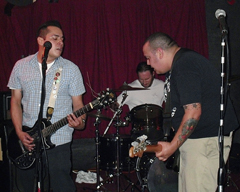
Killdevil
The night started off with alternative indie rock trio Killdevil, which didn’t quite fit the punk ticket, but delivered several energetic songs nonetheless. Songs like “Last Reptile” featured a signature indie rock sound, delivering distortion-packed guitar riffs as vocalist Alex Dorame wailed into the mic over the humming bass. Brothers Art and Alex Dorame have been playing as Killdevil for four years now, with Art on guitar and Alex on bass. The two praised their new drummer between songs for playing his first show with them live.
Next was Joe Q. Citizen, four guys hailing from San Jose, Calif. If a punk band can be classified as suave, these guys were proof. Their choice of gear was minimalistic, with only one pedal in sight. They didn’t need more. They commanded the stage with short, fluid pop-punk songs like “Dumb in Love” and “Diggin Out,” making their job look effortless. Guitarists Dover One and Shawn Packer strummed out swift chords over Julian Ostrow’s–whose shirt was off by the second song–fleet-footed drum tempo. “Whiskey in My Panties” was another favorite, garnering audience catcalls.
Four-piece band Riot Radio followed, the only band boasting female members that night. They are a newer band on the local music scene, and their sound fits somewhere in the midst of garage and hardcore punk. Vocalist/bassist Kat was full of piss and vinegar–who knew the petite, feathery-haired redhead could release such a powerfully raw, growling voice? It’s not easy to come by in a female vocalist. The band’s fierce drummer Maggie crashed away at the drums with gusto while Kat and guitarist Jeff exchanged nonstop shrieking call-and-response vocals, not a single word of which could be understood. Song after two-minute raging song should have left ears bleeding by the end of their set.
By the time Armed Forces Radio took the low-lit stage after midnight, the audience had thinned down to lone beer-carrying stragglers. The first song was introduced with the bassist drumming a beer bottle against his strings, leading into the song “Manifest Destiny.” Their songs had a punk/ska flavor and the Clash influence was unmistakable. More people magically appeared, gathering around the stage to watch as vocalist/rhythm guitarist Albert crooned anti-war songs like “Compassion of a Bullet” with the same raspy lisp as Joe Strummer. With beers in hand the crowd broke into a peaceful, short-lived mosh pit during “Ghosts of Babylon.” It was the most animated the audience had been the whole night. As the last song drew to an end, Albert was drenched, sweat and spit dripping down his chin.
What caught me by surprise was the fact he used a Taurus Polytone practice amp not much larger than a microwave to play the set, which he had positioned on top of a chair. Submerge caught up with him afterward to ask about it. The amp he usually plays with was in the shop, he said.
“Punk rock taught us to make do with what you have,” he said.
If that’s not a sign that punk is alive and kicking, I am not sure what is.
Hero’s Last Mission’s Debut LP Not as Metal as You’d Think
“People will look at us like, ‘You are the most metal-looking, pop rock band I’ve ever seen,” drummer Julian Mendoza from Hero’s Last Mission told Submerge over coffee recently. With their black T-shirt, long hair and goatees, the local five-piece certainly looks like a metal band. However, their metal look is a running joke, Mendoza said.
“I mean, I wear shirts like this all the time,” he said, looking down at his black Electric Zombie T-shirt. “And our bass player is always wearing Converge shirts and Protest the Hero shirts.”
So when they begin to play at an open mic night at, say, Pangea, Fox and Goose, Townhouse or Old Ironsides, sometimes the audience is surprised.
“We’re so happy when we’re playing,” guitarist Art Padilla laughed.
The band’s first full-length album, Stay on Course, available online for free download throughout May, is a far cry from metal. Rather, the album strikes a solid balance between rock and pop. Songs like “Gamblin’” feature fast tempos and guitar shredding, while other songs, like “Right Here,” are unmistakably pop, brimming with harmonies, melodic guitar solos and pop-y choruses.
Lyrically, several of the songs speak of dealing with hard times, reflecting some of the experiences the band faced while recording. In “Killing Me,” for instance, vocalist Lee Hurtado laments trying to keep his composure during heartbreak.
“Any time there’s a situation that may be negative, it’s something that inspires us,” Mendoza said.
Despite break-ups and break-ins during the recording process, HLM has managed to stay positive and focused, which is why they chose to title the album Stay on Course.
“It’s hard to promote yourself and be an independent band and keep on going,” Padilla said. “Other bands stop because they get frustrated, but we love playing. We’re not going to settle.”
Hardships, along with three major tours, including last summer’s Let’s Get Dangerous tour, have allowed the current band members plenty of time to bond since they came together in 2009. They can laugh about the time they spent the night in a police station while on tour. It wasn’t because they were in trouble; it was because a cop let them stay there after finding them pulled over in a “nice neighborhood” to sleep for the night.
Sharing van space has also allowed them plenty of opportunities to influence one another’s music taste. Rolling down long stretches of highway in the tour van, anything from Slayer to Journey, Rascal Flatts to Coheed and Cambria, is fair game.
“And we’ll sing to all of them,” Padilla said.
“I used to be into harder music,” Mendoza said. “But there’s just so much. We listen to everything.”
Even when they’re not on tour, the band mates spend a lot of time around each other. Lee and twin brother/guitarist Luis Hurtado, both from Amador County, now live with Padilla in Sacramento.
“I’ve adopted twins!” Padilla laughed.
Though the band spent part of its time recording the album at Pus Cavern recording studio in Sacramento, the rest of the album was recorded at the Padilla-Hurtado house.
“People just come in,” Padilla said. “It’s like a sitcom with Kramer where he opens the door and says, ‘I’m here guys.’ So there’s no knocking anymore. If you want something from the fridge, go get it yourself.”
Recording pieces of the album within the comforts of home helped to spark the band’s creativity, Mendoza said. Without having to work under time constraints, the five had the ability to work freely and try different things, like adding more guitars to a track.
As a result, the songs on this album are more diverse than those on the last two EPs released by the band in 2006 and 2008, Mendoza and Padilla agree.
Most importantly, the musicians agree that what has really brought them together is their pure love for playing music.
“We’ll play anywhere,” Mendoza said.
If someone were to say, “You guys wouldn’t play there.” Padilla said, “Yeah we will.”
“And we’ll just get in a little corner probably about this big,” he said while motioning a small space. “And we’ll just play a show.”
Sometimes the band will play an acoustic set, and Mendoza will bring a cajón, kick, snare or high hat.
“Or whatever, it doesn’t matter, because I think people will see that we love to play,” he said.
On more than one occasion the band has been caught off guard and unequipped for a request to hear some of their stuff.
“And we’re like, ‘We don’t have our instruments.’ And then one of the five of us will be like, ‘Well we can do a cappella,’” Padilla said.
Even when they’re not dropping songs a cappella style on the spot, rarely does the band spend time doing things unrelated to music.
“It’s kind of like non-band time doesn’t exist because we’re always on band time. Even when I’m at work,” Padilla said. “I’m getting a text right now from a band I manage; they need help and they’re always asking for my advice.”
HLM has also received overwhelming support for their dedication. Their album was partly made possible through donations made by supporters on Kickstarter.com, a site that allows artists to collect donations in order to fund their creative projects.
The band offered anything from hugs, hard copies of the album, invitations to album screenings or concert tickets based on the size of the donation made. In the end, they received an amount greater than what they had asked for to fund the making of the album.
A $1,000 donation came from a café owner in Amador County who really wanted to see the band’s success.
“So now she gets a show, it’s the least we could do,” Padilla said.
With a growing fan base and the release of their latest album, HLM has no intention of slowing down.
“We know we need to get out and we just want everyone to see us, whether that’s going to be a more organized tour or just a bunch of shows every day, even if it’s open mics,” Padilla said.
So should you see five guys dressed in black at an open mic night around town, hold off on the head-thrashing. They might not be the metal band you were expecting.
Hero’s Last Mission will celebrate the release of Stay on Course at Shenanigans in Sacramento on May 21, 2011. Tickets are $7 in advance, $10 the day of the show, which gets underway at 7 p.m. To download Stay on Course for free or to purchase a ticket to the show at Shenanigans, go to Heroslastmission.com.
Walking Spanish’s sophomore album Wishbones strikes a balance
You could say Alex Nelson lives a scattered lifestyle. Somewhere in between picking up freshly pressed CDs, getting car steering fluid and heading to a wedding rehearsal dinner, the frontman of local band Walking Spanish found time to sit down over coffee and discuss the upcoming release of his band’s second album, Wishbones. It seems Nelson is ready to adapt to whatever situation is thrown his way. At his heel lay a backpack holding his computer, a change of clothes, cigarette coupons and a flask of bourbon, amongst other things. The first half of the following day would be spent as a groomsman in the wedding of a close friend, while the latter would be spent playing a show at Old Ironsides alongside Nicki Bluhm and the Gramblers.
Walking Spanish has become the centerpiece of Nelson’s life since he first formed the band with two friends in high school. Eventually he made it his own, writing all of the songs and assuming the role as band manager. The band’s evolution is apparent in Wishbones, he said. It is a versatile blend of well-structured songs, combining country, rock ‘n’ roll and pop, littered with subtly haunting, poetic verse.
After listening to the album, I met with him again outside Luigi’s Slice as he polished off a piece of pizza over the hood of his Honda just an hour before band practice.
Here is what the soon to be 23-year-old had to say about the new album, songwriting inspiration and maturing.
In terms of this record that’s coming out, how would you say it compares to the first record, or what should the fans expect? How do you think they’ll react?
I think they’re gonna go, “Whoa,” because it’s much different. I mean it’s still rock ‘n’ roll music but there is a lot more to this record. You’re listening to my songwriting and our band’s level of musicianship and our level of creativity. All those things, all those elements between this record and the first record, it’s, at least in my opinion, signs of maturing. To me, that means, just basically, that it’s better. [Laughs] To me, that just means that I’ll listen to a song and just be like, “Aw man. That’s a way better song than what I would’ve written when I was 18.”
Can you tell me a little bit about the song “Counterfeit Wishbones?” What inspired it?
I can tell you the emotion that arises from me is the feeling of being caged, and the idea of the “Counterfeit Wishbones,” you had chances to get out of the cage, but they were just counterfeit. When I was teaching this song to the band, I said I want this to sound like a tiger trying to get out of a cage. So I guess that’s kind of the theme of that one. As far as the lyrics go, the lyrics were inspired by, well, I’m not really sure. You’d have to dig really deep into my psyche to find out where those came from.
So why did you title the album after it?
I thought it would be kinda cool. I thought Wishbones sounded cool. Every song I write is like a piece of my mind, and if I’m putting out my words and my ideas out into the world, it’s almost like a wish. So Wishbones is kind of a neat voodoo thing that kind of has that whole theme attached to it. But it’s also like wishbones, there’s a winner and a loser. Which is kind of the way I look at the world, everything that’s good has its counterpart somewhere in the world, whether it’s directly related or not. There’s balance to everything.
So was there an inspiration for the song “Jacksin?”
Yeah. It’s kind of the same way that it’s fun to play video games where you shoot people, because you don’t really get to do it in real life. It’s kind of the same way I like to write a song. I wanted to get into the place to tell a story about an experience that I’ve never experienced and an experience that I don’t ever hope to experience, but by singing about it and trying to write from the standpoint of somebody who’s like that, and went through that kind of a situation, it’s almost like I was able to live it in that way. I mean, it’s obviously fictional, it’s just a story. A story that I think is a realistic story, because those things happen.
Where’d you get all the music influences?
Listening to it growing up. Growing up.
But I mean, parents? Or…
Oh yeah, well I had a good kick start, coming from a family that listens to a lot of music. So, my parents were divorced since I was 8. So I lived with my mom, and my mom had a good record collection. But even more so did my two older brothers that had record collections that were even more varying. My oldest brother had all kinds of old records from all different time periods. He had phonograph records, and CDs and tapes, and all kinds of collections of music stuff. And then my brother Brian, he had White Zombie records, Rage Against the Machine. And I got really into those bands, too.
So, speaking of brothers, your oldest brother is Jackie, Jackie Greene. So it looks like when you did this album, you were in his recording studio, right?
Right. Well, it’s Tim Bluhm of the Mother Hips. It’s his space. Jackie used it, though.
How is it working with your brother?
Working with my brother? You know, the funny thing is, that’s probably the most relevant question that anybody could ask when they’re asking about Walking Spanish and they’re pertaining to Jackie Greene. Nobody ever asks me how it is working with my brother. Everybody always asks, “Have you ever played with your brother?” Or whatever, things like that. It’s funny you asked that question.
It’s great, it’s wonderful. I imagine working with somebody who doesn’t understand me and what I’m trying to do as well as my brother wouldn’t be as easy. Because I can come up with an idea, and I only have to explain about a quarter of it and he’ll be like, “Oh yeah, I get where you’re going with that.”
Do you have any free time?
[Laughs] Yeah, sometimes. No, I do, that’s not fair. I have friends who work two jobs and go to school, and I have a lot of free time compared to them, because everything I’m doing is what I want to do. So it’s almost all free time.
And that’s the band?
Yeah. Everything I do is for that pretty much and that’s my job. So that’s what I do all day, that’s what I do all night. And during my free time I’m probably playing music anyways, or playing in another friend’s band. Or playing baseball with my brother for exercise in batting cages. Yeah. Playing with my dog. Reading books. Going to bachelor parties.
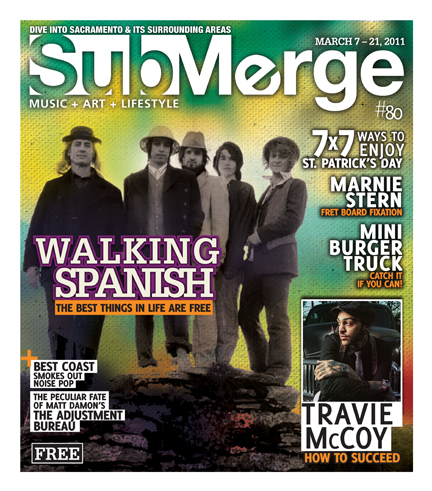
Walking Spanish will celebrate the release of its second album at Old Ironsides on March 25. Prieta will also perform. It will be $7 to get in, and the show starts at 9 p.m.



